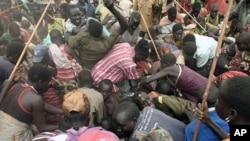The World Food Program has warned clashes along the border between Sudan and South Sudan threaten to plunge the region into widespread hunger. The U.N. agency said it is scaling up its humanitarian operation in South Sudan to assist a growing number of refugees and displaced people.
The World Food Program said the food security situation was already precarious in Sudanese border states. Now, it said the recent fighting along the two countries' disputed boundary threatens to displace more people and disrupt already fragile livelihoods.The U.N. food agency plans to assist 2.7 million people in South Sudan this year under an emergency operation covering the border region and other areas.
But WFP spokeswoman Elizabeth Byrs said her agency is particularly concerned about the critical situations in South Sudan's Unity State and Upper Nile State. She said thousands of refugees and displaced people were there before the recent fighting erupted and their numbers are growing daily. “These people are already in a very dire situation, and now with the clashes their situation is going to worsen," Byrs said.
"WFP is planning and is assisting 140,000 people for the next six months and to assist those people, we have pre-positioned 14,000 metric tons of food,” she added.
Byrs noted the World Food Program has had to act quickly to pre-position food this year because the rains that normally start in July have begun. She said rainy season lasts until October. During this time, the roads are impassible.
She said World Food Program is providing special supplementary, nutritional feeding to about one-half-million young children, pregnant women, and nursing mothers who are suffering from, or are vulnerable to, malnutrition.
“The recent food security and monitoring system assessment indicates malnutrition rates among children under five have reached levels above the global acute malnutrition-rate emergency threshold, which is 15 percent in four states in South Sudan including the two states, Unity State and Upper Nile State," Byrs said.
The World Food Program also said s helping other humanitarian agencies establish a humanitarian lifeline for the affected population. For example, the agency said as deployed trucks and two helicopters to deliver medical kits, shelter items, fuel and other assistance.









